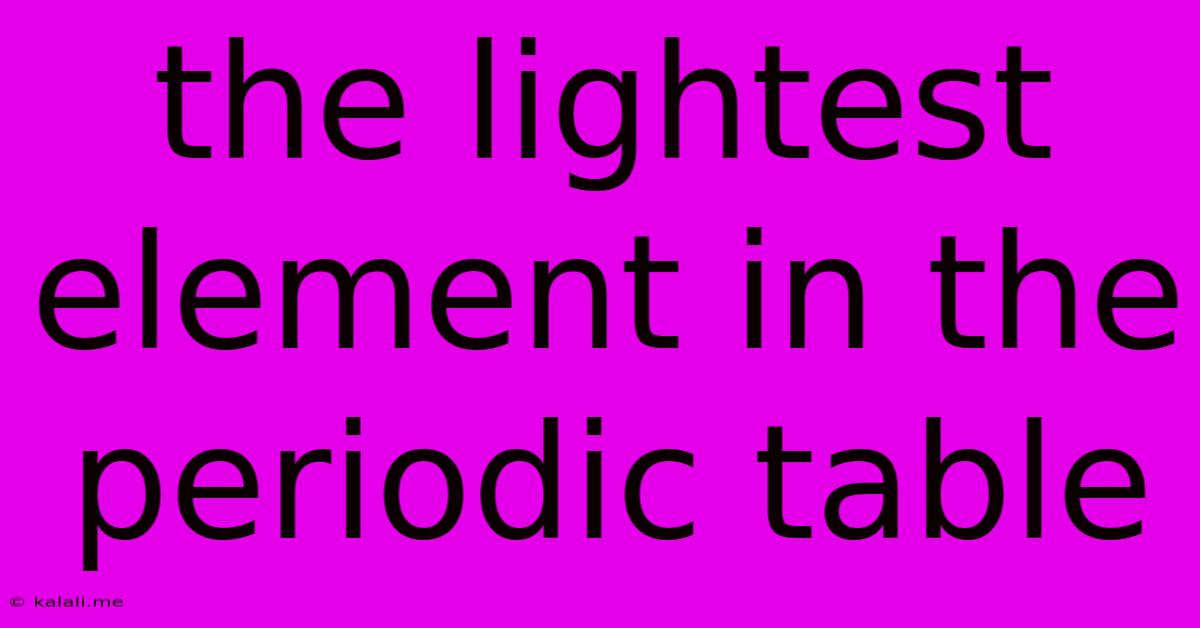The Lightest Element In The Periodic Table
Kalali
Jun 14, 2025 · 3 min read

Table of Contents
The Lightest Element: Unpacking the Wonders of Hydrogen
Hydrogen, the element residing at the very top of the periodic table, holds the coveted title of the lightest element. This seemingly simple atom, composed of a single proton and a single electron, plays a surprisingly significant role in the universe and our everyday lives. This article delves into the fascinating properties, applications, and future potential of this remarkable element. Understanding hydrogen's unique characteristics is key to appreciating its crucial contributions to various fields.
Hydrogen's low atomic weight and abundance make it a fascinating subject of study for scientists and engineers alike. Its properties have driven significant advancements in energy production, industrial processes, and even space exploration. Let's explore what makes hydrogen so unique.
Properties of the Lightest Element
Hydrogen's lightness is a defining characteristic, making it less dense than air. This property has implications for its use in various applications, such as lifting agents in balloons (though helium is safer and more commonly used nowadays due to hydrogen's flammability). Beyond its low density, other key properties include:
- High reactivity: Hydrogen readily reacts with other elements, forming various compounds. This reactivity is both a blessing and a curse, leading to its versatility in chemical processes but also posing safety challenges.
- Abundance: Hydrogen is the most abundant element in the universe, comprising roughly 75% of all normal matter. However, it's rarely found in its pure elemental form on Earth, typically existing as a component in water (H₂O) and organic compounds.
- Isotopes: Hydrogen boasts three isotopes: protium (¹H), deuterium (²H or D), and tritium (³H or T). These isotopes differ in the number of neutrons in their nuclei, leading to subtle variations in their properties. Deuterium and tritium have specific applications in nuclear research and fusion energy.
- Colorless, odorless, and tasteless gas: In its gaseous state, hydrogen is undetectable by the senses, requiring specialized instruments for detection. This characteristic necessitates careful handling to prevent accidents.
Applications of Hydrogen: From Fuel Cells to Ammonia Production
Hydrogen's versatility shines through its diverse applications across various sectors:
- Energy: Hydrogen is viewed as a promising clean energy carrier, particularly in fuel cells that convert hydrogen and oxygen into electricity, generating only water as a byproduct. Hydrogen fuel cells power various applications, from vehicles to stationary power systems.
- Ammonia Production: The Haber-Bosch process, a cornerstone of industrial chemistry, uses hydrogen to synthesize ammonia (NH₃), a crucial component of fertilizers. This process underscores hydrogen's critical role in global food production.
- Metal Refining: Hydrogen's reducing properties are employed in metal refining, helping to extract pure metals from their ores. This application contributes significantly to various industries, including manufacturing and construction.
- Chemical Synthesis: Hydrogen is a key reagent in numerous chemical synthesis processes, contributing to the production of a wide range of products, from plastics to pharmaceuticals.
The Future of Hydrogen: Challenges and Opportunities
Despite its potential, the widespread adoption of hydrogen faces several challenges:
- Production costs: Producing hydrogen efficiently and cost-effectively remains a hurdle, with many current methods relying on energy-intensive processes.
- Storage and transportation: Storing and transporting hydrogen safely and efficiently presents logistical complexities due to its low density and flammability.
- Infrastructure limitations: A lack of widespread infrastructure for hydrogen production, storage, and distribution limits its broader adoption.
However, ongoing research and development are addressing these challenges, with promising advancements in hydrogen production from renewable sources like solar and wind power. The future of hydrogen looks bright, with the potential to revolutionize various sectors and contribute to a cleaner, more sustainable energy future.
In conclusion, hydrogen, the lightest element, is far from insignificant. Its unique properties and diverse applications make it a crucial player in various industries, with its future role in clean energy production shaping up to be particularly pivotal. Continued innovation and investment will be key to unlocking hydrogen's full potential and addressing the challenges associated with its widespread adoption.
Latest Posts
Latest Posts
-
How Does Representative Democracy Differ From Direct Democracy
Jun 14, 2025
-
Is Dembele Right Or Left Footed
Jun 14, 2025
-
The Ends Of A Long Bone Are Known As The
Jun 14, 2025
-
Most Abundant Metal In The Earth Crust
Jun 14, 2025
-
The Area Under A Velocity Time Graph Represents
Jun 14, 2025
Related Post
Thank you for visiting our website which covers about The Lightest Element In The Periodic Table . We hope the information provided has been useful to you. Feel free to contact us if you have any questions or need further assistance. See you next time and don't miss to bookmark.